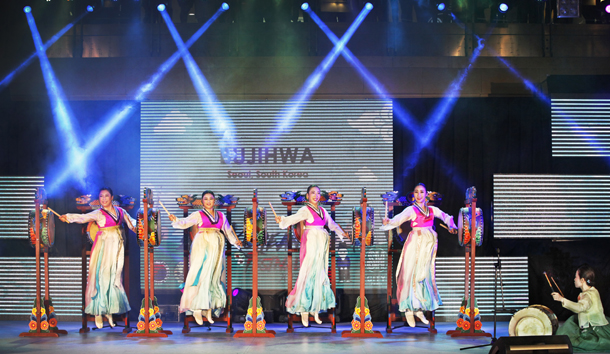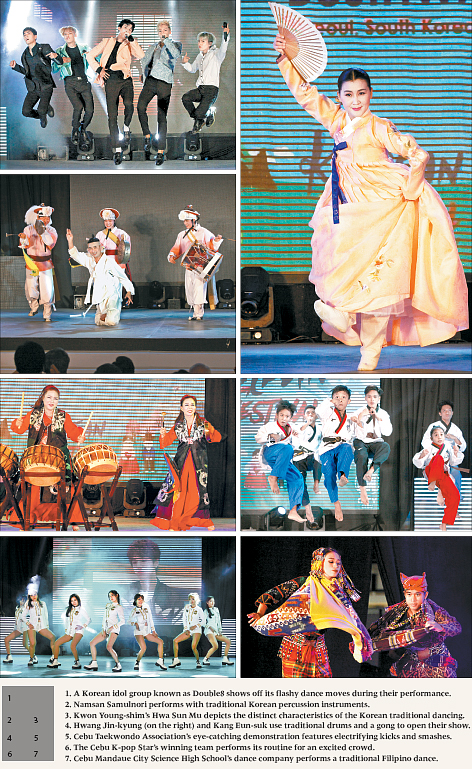[ZOOM KOREA] Sounds of Korea ring out in the Philippines

The gugak performance team Bujihwa performs the dynamic and energy-filled samgomu, or Korean drum dance, for the crowd at the 2017 Cebu K-pop Star event in Cebu, Philippines. [PARK SANG-MOON]
These are the words of Nikki, who cheered while watching the performances at “Korea Day,” an event hosted by Cho Bong-hwan, the head of the Cebu Korean Association, on Sept. 30 in Cebu, Philippines. Nikki enjoys not only K-pop but also watching Korean dramas and movies, and she has learned Korean in the process. In 2015, she even won an award at a Korean speaking contest and was given the opportunity to visit Korea to study for one month at Hanyang University’s Institute of International Education.
The event, now in its seventh year, has traditionally been held on the first Saturday of October. However, due to Korea’s exceptionally long holiday in October this year, the festival was held a week earlier at Cebu’s SM City Mall, and attracted 1,000 people who came out to enjoy the colorful performances.
Groups who made the trip from Korea included a gugak (Korean traditional music) performance team, a samulnori (Korean traditional percussion) team and a boy band named Double8.
The performers from the Philippines included Mandaue City’s high school dance team, a traditional Philippines dance team, the Cebu Taekwondo Association and a seven-member girl group named Merge, who were named the winners of the 2017 Cebu K-pop Star competition.
There was also a fashion show featuring hanbok and baro’t saya, the traditional clothing of Korea and Philippines. Moreover, a nine-year-old Filipino girl named Sophia sang “Arirang” on stage to commemorate the event.
The Korean performances started off with the clear-cut sounds of Bujihwa, the gugak team. A solemn drum roll grabbed the audience’s attention and the group’s gong added excitement to the music. The four professional dancers who appeared on stage right after the energetic introduction roused the audience with their dynamic and vigorous choreography.
Dancer Kwon Young-shim’s flower and fan dance routine known as Hwa Sun Mu showed off the essence of Korean traditional dance. Created in 1978 by the dancer Im Ijo, the performance is a based on the fundamentals of Korean traditional dance. Her steps were delicate and sensitive, giving off a ladylike charm.

[PARK SANG-MOON]
The Filipino dancers performed as if they were dancing in a great ballroom, filling the entire stage in jovial celebration.
Miss Cebu appeared as one of the models in the event’s fashion show, creating a stir among those in the audience who craned their necks to get a glimpse at the beautiful pageant star.
After a taekwondo demonstration from a local team dazzled the crowd with its kicks and smashes, the stage became a K-pop extravaganza. The girl group Merge gave a passionate performance.
The group was chosen to perform after a fierce competition between 130 teams was held in the weeks prior. The event’s grand finale was from idol group Double8. The atmosphere was electric, and the cheers of fans filled the entire mall. Children and adults alike went wild, rooting for the group’s performance.
There were also attractions for those in attendance to enjoy, such as the Cebu City mall’s cinema screening of Korean movies for free over four days.
“Incheon Open Port,” a social enterprise from Incheon, opened its own bazaar selling Korean products to locals. The Cebu Korean Women’s Association opened a stand for Filipino people to experience Korean culture, including trying on hanbok and tasting Korean foods.
According to Oh Sung-yong, the South Korea’s consular representative in Cebu, the total population of Cebu city is estimated to be 4.3 million and about 20,000 Koreans currently live in the city.
Around 840,000 Korean tourists visited Cebu in 2016 alone. Korean tourists make up 42 percent of the total foreign tourism in Cebu - a large proportion of the Cebu’s tourism industry.
Although Cebu had such a close relationship with Korea, there has never been an opportunity for local residents to encounter Korean performances.
To the locals, “Korea Day” was like the silver lining from the clouds, a little ray of excitement for them to enjoy something new from a country they are familiar with.
At the end of the day, the people left with huge smiles on their faces, speaking excitingly about what they saw on the stage.
Every person walking out the door was preciously holding onto autographs the performers had signed for them at the end of the show.
BY PARK SANG-MOON [moonpark@joongang.co.kr]










with the Korea JoongAng Daily
To write comments, please log in to one of the accounts.
Standards Board Policy (0/250자)